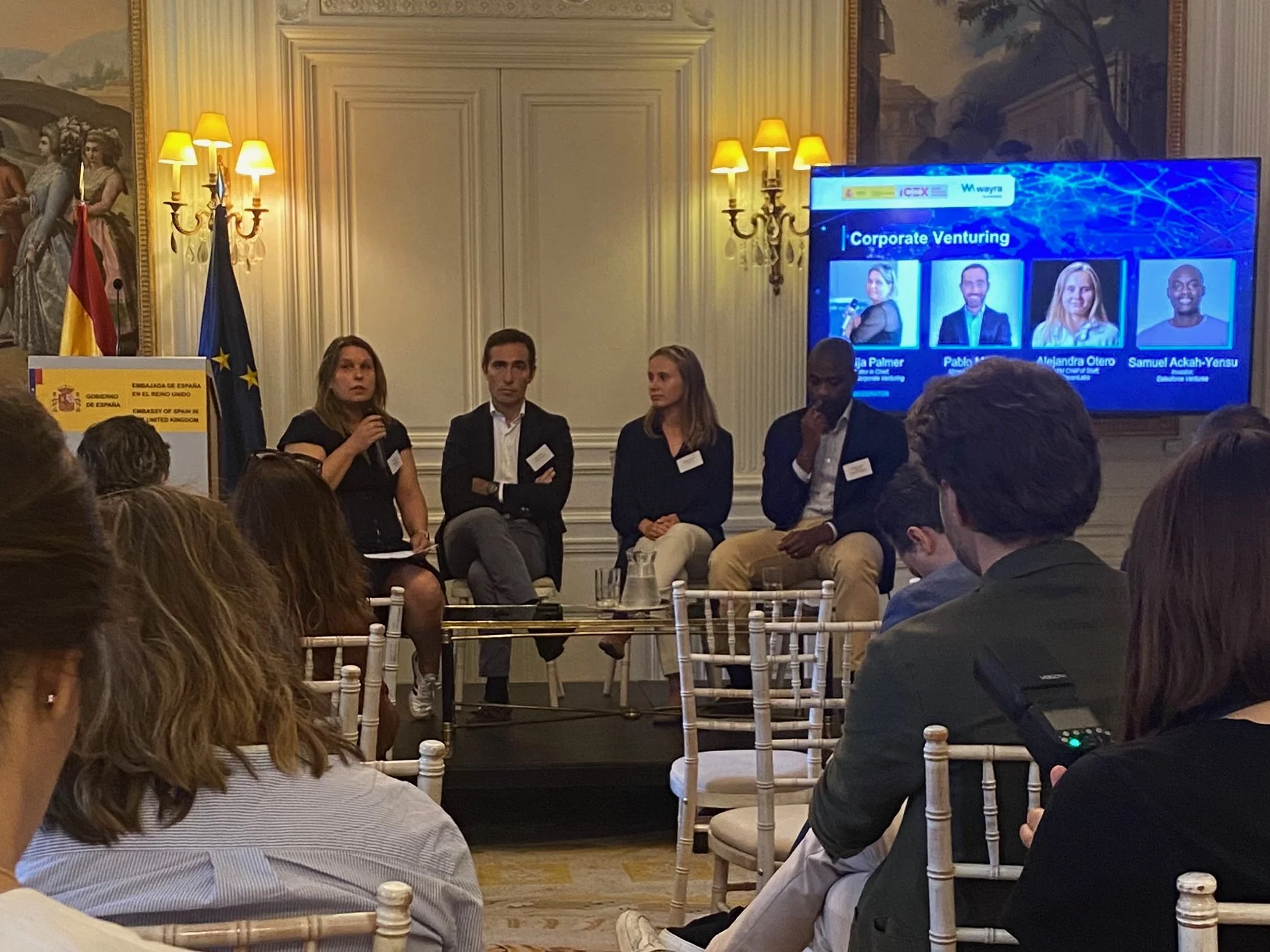Why CVCs Must Lead with Strategic Communication
Corporate Venture Capital (CVC) has come of age. No longer a shadow to traditional VC or simply an R&D extension of parent firms, today’s CVCs are strategic powerhouses, blending capital with capability, and investing not just money, but deep industry insight, global networks, and operational advantage into the companies they back.
This past week, at the Global Corporate Venturing Symposium in London, I participated in panels and conversations with innovation leaders, fintech entrepreneurs, policy officials, and CVC professionals. We explored everything from the rise of university spinouts to the challenges of financial reform. But a unifying theme ran through it all: how CVCs are uniquely positioned to drive innovation and scale with smarter, more sustainable outcomes, and why trust, perception, and strategic communications are critical enablers of that success.
From Capital to Capability: The Evolving Role of CVCs
CVCs differ from traditional VCs in ways that can give founders an edge. They bring insight from operating businesses, understand procurement and regulation inside and out, and are often part of global supply chains.
One speaker from a major Middle Eastern financial institution explained how their venture arm, though new, was building bridges between fintechs and their core banking operations, not just for innovation theatre, but for practical deployment and scale.
This advantage matters. Founders backed by CVCs gain access to not only funding but also commercial pathways, technical expertise, and procurement opportunities that pure-play venture capitalists (VCs) simply cannot offer.
Yet, as many agreed at the symposium, this strategic advantage can only be fully realised when the CVC and the portfolio company speak the same language, and that’s where communication comes in.
Communications as Strategy, Not Just Output
Too often, communication is treated as an afterthought a tactical activity where the focus is on PR, social media, press releases, blog and/or campaign slogans. These are tools, not strategy.
True strategic communications sits upstream. It clarifies identity. It aligns perception with purpose. It builds trust with investors, policymakers, partners, talent and prospective investment partners like family offices.
And in a world where markets move on confidence and capital seeks clarity, it is as critical as your cap table or product roadmap.
When speaking to founders and CVC professionals alike, I often ask: “How do others see you, and how much of that are you shaping versus reacting to?” It’s a crucial question, particularly when scaling internationally or preparing for follow-on fundraising.
Communications, when embedded from the start, can do four essential things for a CVC-backed company:
Accelerate Trust: Through clarity of message and consistency of presence, start-ups earn the confidence of new customers, regulators, and investors.
Position for Growth: Companies that know how to tell their story can attract the right partners and talent at the right time.
Build Strategic Advantage: Messaging rooted in market understanding and corporate strategy can differentiate you in crowded sectors.
De-risk the Narrative: Anticipating scrutiny (especially in regulated sectors) and shaping the story reduces reputational and operational risk.
The Power of Perception in Private Markets
The conversations at the symposium also explored the reform of private markets and innovations in secondary share trading. Mark James, who is leading work around the Private Intermittent Securities Exchange System (PISCES), described how this new model aims to bring liquidity to private firms, through regulated, one-day share auctions that allow founders and early backers to realise value without going public.
This is significant. A lack of liquidity has long been a barrier for many founders and investors. But it also introduces a new layer of scrutiny. As private market visibility increases, so does the importance of reputation and perceived performance. Price transparency, investor confidence, and capital flow are no longer just functions of financials, they are also shaped by sentiment, perception, and trust.
Strategic communications becomes a critical input in these environments. It provides companies with the tools to shape their investor narrative, manage the timing and tone of announcements, and maintain discretion where required.
As one CVC leader put it, “For every investor that wants more transparency, there’s another who wants less.” Communications must navigate that tension with discipline and tact.
Communications, both tactical and strategic, help shape confidence, which is critical in capital markets, specially when fundraising. As I’ve said before and organisations like Lloyds of London have confirmed with their own studies and data, valuations of companies are influenced by the value of reputation, an intangible asset. If you think solely about communications from the perspective of of tactical comms - PR, blogs and social, then there is a misunderstand of how strategic communciations can help steer a company to growth.
University Spinouts: Innovation’s Untapped Arsenal
One of the most energising sessions I joined, which followed on from an event I attended at the SFO Week in May, focused on university spinouts. Institutions like Oxford, Cambridge, and Imperial are attracting global IP and academic talent, with interest accelerating due to shifts in US higher education and global geopolitics. And yes, US researchers are already looking at moving over The Atlantic. Perception matters and influences decisions.
Yet spinouts face a complex challenge. They are often rich in IP but lean on commercialisation experience. Their founders are researchers, not entrepreneurs. Their language is scientific, not strategic.
Here again, communication plays a bridging role, in both the strategic advisory and positioning.
It’s not enough to have a breakthrough; you must communicate it in a way that resonates with funders, regulators, and industry. As I said during one conversation, there’s the “public side of comms,” your website, your LinkedIn, your media coverage, but the private side is even more vital. For many companies and spinouts, it requires a model where, as an example, 80% of time is spent with more private and strategic positioning and the remaining 20% if more tactical.
Again, as an example, from my early days supporting charities and NGOs over 30 years ago. Charity fundraising is split between the public side that we all see, the fundraising runs, people sponsoring cake stalls and challenges - activities that are equally critical to win over public support, but the big ticket fundraising from charitable trusts, corporates and foundations, who lend in big numbers. The psychology is perfect. You need £10 million, when £8 million is raised privately, go public and ask people for support the remaining. People tend to be morereceptive.
That’s the work of aligning your story to your business outcomes and shaping how you are seen by those who matter most: prospective investors, regulators, and partners.
This becomes even more important as UK universities scale their IP commercialisation activity. The risk is not the science, it’s the signal.
Communicating value clearly, at the right time, to the right audiences can mean the difference between a licensing deal and a lost opportunity.
CVCs as Builders, Not Just Backers
There’s a fundamental difference between CVCs and many financial investors. CVCs understand timelines. They know that deep-tech and industrial innovation takes longer to commercialise. They operate inside regulatory environments. They see innovation not just as financial upside, but as a strategic necessity for their sector and their own corporate. It forms part of a wider strategic vision of planning for the long term.
And this long-term view is powerful if harnessed well.
The GVC Institute and GCV’s network play a vital role in sharing operational knowledge and facilitating peer learning among CVCs. At the symposium, there was honest discussion about the friction that can exist between a parent corporation’s priorities and a CVC’s investment goals. But there was also a clear appetite for solving it through internal education, strategic alignment, and communications that reflect both the independence and the integration of CVCs.
One of the more powerful observations made was that “CVCs can help start-ups succeed because they understand supply chains and internal procurement better than most.” That’s insight no Series A fund can buy. Strategic communications can amplify that advantage by packaging knowledge into a reputation, turning operational value into perceived value.
The GCV Powerlist 100
The Case for a Communications Playbook for CVCs
If you’re a CVC leader reading this, here’s what I’d advocate:
Treat Your Reputation Like an Asset: As Lloyd’s of London and KPMG report that i highlighted before said, reputation can account for over 25% of a firm’s market value. And it’s even more pronounced for early-stage companies, where visibility and perceived credibility drive deal flow.
Embed Communications into Due Diligence: When investing in companies, assess not only their tech or team, but their readiness to communicate clearly, strategically, and with impact. Build that ability early.
Offer Non-Capital Value Through Communications Support: Your portfolio companies need more than just cash. Equip them with narrative development, media training, and stakeholder engagement tools. That’s what makes a founder confident in front of a sovereign wealth fund or a government panel.
Engage Policymakers with Clarity and Purpose: Many of the innovations you back will face regulatory scrutiny. Helping companies prepare and shaping the policy environment around them is a role few CVCs play, but should. You want a narrative that gives regulators and other investors confidence and where there are issues these need to be resolved privately.
Measure Perception as a Leading Indicator: Just as you monitor run rate and burn, track perception in relevant stakeholder groups. It’s often the best early signal of future fundraising, partnership, or acquisition potential.
Why Now Matters
As we look to the second half of 2025, the context is both urgent and hopeful. Capital markets are evolving. Regulatory reform here in the UK is underway. Equally, within the EU there are movements to deregulate and change the culture so that the innovation that is created within this trading block can scale. IP is moving across borders. The UK, in particular, is in a “Goldilocks” moment for innovation, with global talent inflows, attractive legal frameworks, and new secondary markets emerging.
But for these opportunities to translate into outcomes, we need more than science and money. We need alignment. We need trust. And we need a narrative.
That’s where communication comes in, as a strategic lever.
If you lead a CVC fund or advise start-ups, ask yourself this: “Are we shaping how your CVC and each of your portfolio of companies are seen? Or are you hoping that your success will be obvious?”
The winners will do the former.








